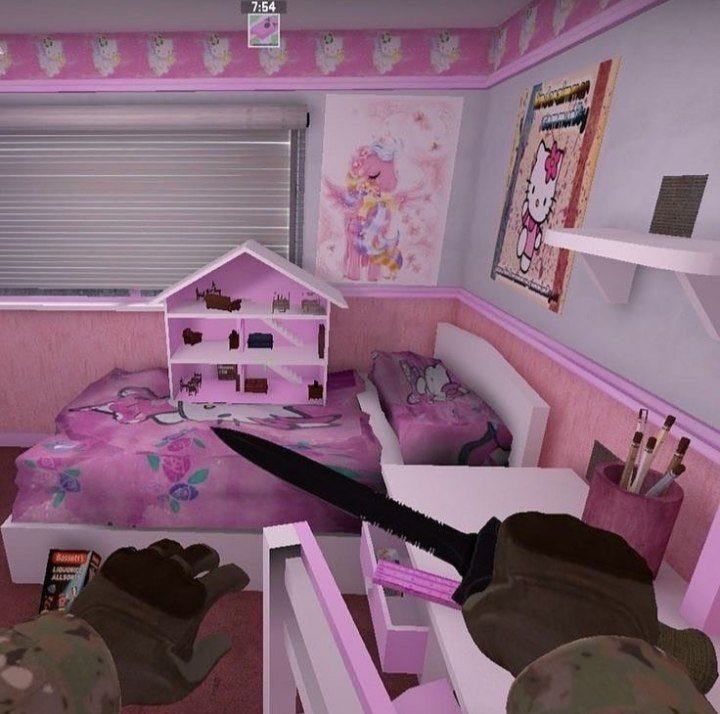Who is 𝑡ℎ𝑒 𝑔𝑖𝑟𝑙?
you might notice them already. The girl online, the transcended body, is fluid and fluorescent. She seeps through your feed, naively amorphous. She has different appearance, the common ones are young and cute, at times angelic, or even prosthetic. The notable essay Everyone Is a Girl Online by Alex Quicho says it all. Quicho illustrated a clear framework, differentiating three forms of girls—symbolic, consumer and inhuman category. She proposed to understand “the girl” as a container, a gender-less and nameless virtual entity. Naturally the question of being/ becoming with technological making is a recursive discourse. In the 1996 reflection on virtual reality and woman, Feminisations, Sadie Plant described: “…women are too artificial for man: a matter of glamour, illusion, a trick. Even her foundations are cos-metic: she's made up…cybernetics is feminisation.” She didn’t use the word “girl”, but in-between passages alludes an emerging world that is surprisingly not so distant from the digital space where resided aforementioned feminine identity. That is, on a neon meadow, all the mammal, pines and intelligence are watched over by the machines of loving grace; the machine is a she.
The girl is pink, dreamy, but also can be violent. Like Noura Tafeche’s project Kawayoku Inception. Tafeche started from the seemingly innocent meme, then tapping into unsettling realm of internet, where the the gamified and cutified female figures become the proxy for obsession for guns and weapons within pro-gun communities. The sublimated violence is brought by military personnel into user’s life through aesthetic that is strongly entangled with sexualization and cuteness. The term Kawayoku comes from a linguistic play freely taken from Japanese language, she explained, Kawaii > cute + Bōryoku > violence, thus Kawayoku.
To me, the word Kawaii is reminiscent of a set of collectable Hello Kitty magnets. It was a crossover with the convenient store franchise 7-11 when I was still a primary schooler. You can see each of the sweet non-gendered cat doing all kinds of activity in varied background, outfits and narratives on the little hologram magnet. They were distributed as a giveaway when the customers spend a certain amount in the store. I remember it was such a fanfare at the time, similar to today’s Labubu maybe, people covet them. They couldn’t resist, the excitement to uncover the small plastic mystique and be surprised by it. They are so palatable. 𝙆𝙖𝙬𝙖𝙞𝙞, my aunt would say, as one of the kitty-magnet zealots.
Let’s look closer. If we look close enough at Hello Kitty, we might be able to identify some resemblance to the girl online. Lurking behind the iridescent surface, Hello Kitty doesn’t fix with one gender and the expectation comes with it; it has changeable costumes to engage in settings; she is soft, light and fun. This pure and petit creature from Sanrio, Japan, departs from its own habitat to the most obscure and grotesque boarder of fantasy.
The Kitty exalts, to a place where angels swarm in the programmed cloud. They install wings with feathers on their back, white as the kitty’s skin.
And I am stuck.
I found myself in the toil of joining the party of angelic girlhood. I recognize the Kitty, recognize the Kawaii-ness, the pink and more. Yet when I spot them on the internet, I can’t. As if someone tries to upload a file, but the format is wrong. Where goes wrong? Is it the sexualized body? The topology of girls? The extrapolation of ways of being a female? Or the playfulness of the conversion to asian femininity? Maybe all of them.
Am I a girl still?
I think of my aunt, she collected those Kitty magnets with me. Is this middle-age asian woman also included in this girlhood imagery? If this is again, another account of white feminist proprietary? Who has the condition to be young, cute, aesthetic, shiny and elusive, cosmetic, in disguise whilst many bodies of others are hidden, unwanted or just too banal?
From Noura Tafeche’s project we could already have a glance of the paradox emerging. That is, while the objectifying gaze, aestheticization, or mysticism is utilized as appropriating method, exploiting reversely the capitalistic and patriarchal system (girl knows the system), there is always a risk of robbing the skin from the anonymous ‘others’, plagiarizing the authenticity and indulging ourselves in the total consumable pretense. On top of that, due to the exact nature of the digital space, the skin is easy to copy and paste. It is effortless to scrap the ‘features’ to be one’s ornament. From simply meme to AI generatives.
On the platform CIVITAI, exhibits plentiful accounts with models that creates realistic images of girls with all kinds of looks. The models are free to download. In the description of the checkpoint named UltraReal Fine-Tune, says:
𝗩𝟰
𝗔𝗹𝗿𝗶𝗴𝗵𝘁, 𝘀𝗼 𝘄𝗵𝗮𝘁’𝘀 𝗻𝗲𝘄 𝗶𝗻 𝘁𝗵𝗶𝘀 𝘃𝗲𝗿𝘀𝗶𝗼𝗻? 𝗜 𝗰𝗿𝗮𝗻𝗸𝗲𝗱 𝘂𝗽 𝘁𝗵𝗲 𝗮𝗲𝘀𝘁𝗵𝗲𝘁𝗶𝗰 𝗱𝗶𝗮𝗹, 𝗮𝗱𝗱𝗲𝗱 𝗺𝗼𝗿𝗲 𝗱𝗶𝘃𝗲𝗿𝘀𝗶𝘁𝘆 𝗶𝗻 𝗮𝗴𝗲𝘀, 𝗮𝗻𝗱 𝗶𝗺𝗽𝗿𝗼𝘃𝗲𝗱 𝗵𝗼𝘄 𝗶𝘁 𝗵𝗮𝗻𝗱𝗹𝗲𝘀 𝗔𝘀𝗶𝗮𝗻 𝗳𝗲𝗮𝘁𝘂𝗿𝗲𝘀. 𝗕𝘂𝘁 - 𝗯𝗲𝗰𝗮𝘂𝘀𝗲 𝘁𝗵𝗲𝗿𝗲’𝘀 𝗮𝗹𝘄𝗮𝘆𝘀 𝗮 𝗯𝘂𝘁 - 𝗜 𝗱𝗶𝗱 𝗻𝗼𝘁𝗶𝗰𝗲 𝘁𝗵𝗲 𝗵𝗮𝗻𝗱𝘀 𝗴𝗼𝘁 𝗮 𝗹𝗶𝘁𝘁𝗹𝗲 𝘄𝗼𝗻𝗸𝗶𝗲𝗿. 𝗘𝗵, 𝗰𝗮𝗻’𝘁 𝘄𝗶𝗻 ‘𝗲𝗺 𝗮𝗹𝗹.
Then goes the prompt: Young woman, early 20s, mixed Asian-European descent, intense gaze directly at camera, striking hazel eyes, dramatic false eyelashes, defined thick dark eyebrows, short straight bangs, long black hair, natural freckles across nose, matte nude lipstick, sharp facial features…
The girl is attractive. She is conflated, distilled into this one plane attraction calling for desire. You see, being asian, asian-european, or others is that easy.
Let’s make her real.
Cloudy Heart, a creation by Jon Rafman, full-on Tumblr trashy band girl vibe. He basically built a reality of her. Cloudy Heart dwells on instagram and other platforms. She has Spotify playlist, telegram community, and merch (she needs to live!). The girl is real, she is attractive. Just as Andrea Long Chu defines— a willingness to sacrifice the self in order to accommodate another's desire, being female in nature essentially has the comparability with the digital space. The traction that emerged surrounding both of the girl and the internet activates preferences, behavior, aesthetic and so on. At one point the figure who/which carries those connections might disappear, disappear in the sense of becoming transparent, accustomed. It becomes ideal.
So maybe, the girl is online; but not in a way of the reinforcing the pretense of a category. The danger of putting a label, in this case, is the online girl framework as the only way to have legitimate claim to the females body interacting/ intra-acting with technological matter. When such use of language dominates, and the semblance floods, people struggle to see the world through any other concept.
When female—in a broader sense— do not fit into the fetishized image of girlhood, they are belittled as they historically have been. The politically and economically deprived, silenced and oppressed female. Female who have lived in a different social and cultural context, experiencing a different corporal reality that is not cute, reckless and attractive. This cutified imagery at worst, can calcify and draw the fetishism to a certain group of female who don’t serve the same functioning on the internet. The functioning supports productivity. It should be consumable, but also not too intimidating like a girl boss; it caters male voyeurism but should fulfill mercenary purpose so to be an exploitation. Being a girl online has plethora of underlying prerequisites.
How to avoid pitfall of stuck on a treadmill of following popular norms and expectations? How to truly be in touch with ourselves? Being aware of the present physicality as part of the digital actor is extremely crucial. There has never been a stance, an organism, a non-human, an information, a matter that could dissociate from the relations with this world. Which includes we, the body that operates the computer, typing, uploading and mattering. It is exactly these acts and no-acts that shapes the ecology of the internet, bestow meaningfulness and dismiss. As the fact that the technological product is artefact cannot be more explicit, who is the human in the making, and which decision is made becomes urgent.
Performing a specific image of ourselves is a regular occurrence in an average person’s life. The girl online and the girl offline mask in a different way, but unmasking benefits all. One day, two girls will meet on the street. The two will whisper and the cybernetic canary will listen. Without the help of cables or chips, they will understand each other perfectly.
ઇ ଓ
𝑔𝓌𝒷








